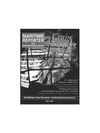
Page 52: of Maritime Reporter Magazine (July 1996)
Read this page in Pdf, Flash or Html5 edition of July 1996 Maritime Reporter Magazine
On February 12, during a storm off the
Brazilian coast, 15,000-dwt SD 14 design ship
Al Johffa went aground in Santos Bay, Brazil, just days before the start of a carnival.
Recognizing the danger of having a large oil spill on the beaches during a heightened tourist season, the vessel's owners and their P&I club — Ocean Marine of London — quickly contract- ed Ft. Lauderdale, Fla.-based Titan Maritime
Industries to remove the spilled oil using local equipment and personnel. The contract was let on February 15, and was followed by a scramble to obtain the necessary equipment and a barge to pump to.
The pumping operation began with the use of "spate" pumps and untested plastic suction and discharge hoses, and continued until four days later — by which time 438-cu.-m. of oil and slops had been transferred. During the oil removal, Titan's on-scene Salvage Master Guy
Wood performed a dive inspection in order to formulate a plan for salvaging Al Johffa.
The ship was lying hard aground on granite for the entire length of its port side, with the number one and two holds tidal, and a slow leak in hold number three. Only three double bottoms were left intact out of 10, and her drafts were approximately 27 ft. (8.2 m) for- ward and seven ft. (2.1 m) aft. The salvage master reported that there was also a rock pin- nacle sticking up three ft. (.9 m) inside the number six double bottom, the shaft tunnel was flooded, and a rock was sticking up about 10 ft. (3.04 m) inside the number two hold. The min- imum water depth on the starboard side was 22 ft. (6.7 m).
Captain Wood decided that refloating would be possible, and removing the wreck by cutting it up would be prohibitively expensive. Despite hiring out of local equipment, a strike in the
Brazilian Customs Office delayed equipment transfers from the U.S., and the vessel suffered additional damage — including the settling of the bow three ft. further underwater — result- ing from the onslaught of another storm.
A salvage team of 24 workers worked around the clock welding down and bracing tween deck hatches for the number two hold, and sealing the number one hold as the tide permitted. The last hatches welded shut — measuring 30 x 30 in. — were the forward trimming hatches on the port and starboard sides — a task which took two workers two tide cycles to accomplish.
On February 19, with the assistance of two local harbor tugs with 2,200-hp each, Al Johffa was refloated just as another front passed through the area.
The vessel was taken to be anchored with a skeleton crew and remained for four days in seas of up to 10 ft. (3 m) before waves were calm enough to permit removal of salvage equip- ment. If the ship had remained aground, she would have undoubtedly broken up.
On February 23, Al Johffa navigated to a posi- tion 393 ft. (120 m) southeast of Santos. The valves that had been used to pressurize the number one and two holds were opened, bleed- ing air out and causing the ship to sink by the bow. In the vessel's final moments, her stern stood straight up in the water and the damage to the number six double bottom and tunnel side tanks could be clearly seen.
For more information on Titan Maritime Industries, Inc.
Circle 117 on Reader Service Card
Canadian Mounted Police Boat
Going Going ... GONE
Severe hull damage and relentless stormy weather helped decide the ulti- mate fate of Al Johffa.
NiOjies
MES Delivers low-Speed
Diesel Powerplant To CEM
An international consortium con- sisting of Mitsui Engineering &
Shipbuilding Co., Ltd. (MES) and its fully-owned subsidiary
Burmeister & Wain Scandinavian
Contractor AS (BWSC) have deliv- ered a 100-MW, low-speed, two- stroke, diesel-driven electric pow- erplant — one of the most powerful in the world — to Companhia de electricidade de Macau (CEM).
The plant consists of two Mitsui-
UAM T> O \%R 1 NIJ-A/MI TR* <-• use on the Navy's next generation of surface warships, but could also be applied in commercial ships. A smaller motor aboard ship means more room for other valuable sys- tems for cargo.
For more information on NNS
Circle 94 on Reader Service Card
Pequots Order first Taurus 60M Marine Turbines For
U.S. Waters
The Mashantucket Pequot Tribal
Council has ordered two 5.2-MW (7,000-hp) Taurus 60M marine gas turbines from Solar Turbines Inc., a subsidiary of Caterpillar Inc., to power the first of a line of luxuri- ous, high-speed 330-passenger
TYiCat ferry boats the Tribe will build in its new Pequot River
Shipworks at New London, Conn.
The twin gas turbine engines will power waterjet units that can "Maximize your bottom time at a minimum cost with nnr

 51
51

 53
53
